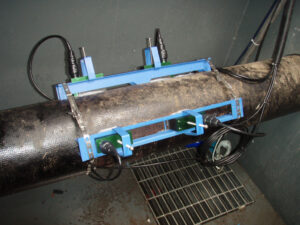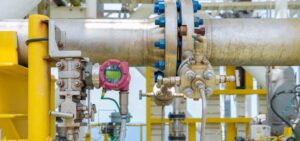Ultrasonic flow meters are devices used to measure the flow rate of fluids in pipes or conduits. They are highly accurate and reliable, making them popular in various industries, including water treatment, chemical processing, and oil and gas production.
In this article, we will introduce the principles and applications of ultrasonic flow meters.
What are Ultrasonic Flow Meters?
Ultrasonic flow meters are devices that use ultrasonic waves to measure the flow rate of a fluid in a pipe or conduit. They consist of two ultrasonic transducers placed on opposite sides of the pipe or conduit, which emit and receive ultrasonic waves.
Transit Time (TT) Ultrasonic techniques
The most common techniques is Transit Time measurement. The ultrasonic waves travel through the fluid returning to the opposite transducer, this time often one million per second is proportional to its fluid velocity. Therefore, the flow rate of the fluid can be calculated by measuring the time difference between the sending and receiving transducer. Transit Time technology is used in 95% of ultrasonic flow metering. See more about Ultrasonic flow meters.
Doppler Ultrasonic techniques.
Ultrasonic flow meters that work based on the principle of the Doppler effect measures the send and receiving frequency of the ultrasonic signal when pointing at a moving particle or bubble inside the pipe or conduit. Doppler flow meter cannot work in very clean liquids because there are no particles or bubbles to bounce the signal back to measure its returned frequency. According to this principle, the frequency of a wave returning to the receiving transducer is proportional to the velocity of particle or bubble inside the flow stream.
This velocity measurement, along with the cross-sectional area of the pipe or conduit, is used to calculate the flow rate of the fluid.
Advantages of Ultrasonic Flow Meters
Ultrasonic flow meters offer several advantages over other types of flow meters, including:
High Accuracy
Ultrasonic flow meters are highly accurate and can accurately measure fluid flow rates within ±1%.
Non-Invasive
Ultrasonic flow meters are mostly non-invasive, meaning they do not come into contact with the measured fluid. This makes them ideal for measuring corrosive, hazardous, or high-purity fluids. However in applications where pipe material, its insulation and liner material and non uniform, transducers are placed inside the pipe.
Wide Range of Applications
Ultrasonic flow meters can measure the flow of a wide range of fluids, including liquids and gasses, making them suitable for various industries and applications.
Bi-Directional Flow Measurement
Ultrasonic flow meters can measure fluid flow in both directions, making them ideal for applications where fluid flow direction changes frequently.
Limitations of Ultrasonic Flow Meters
While ultrasonic flow meters offer many advantages, they also have some limitations, including:
Limited Performance in Non-Uniform Flow
Ultrasonic flow meters can struggle to provide accurate measurements in some applications because of the inaccuracies of speed of sound in non uniform pipe material, very high temperatures, pipe material, pipe liners and/or insulation . Once has to know the speed of sound of various material which also vary with temperature. For instance the speed of sound varies with temperature and changing temperature can affect its accuracy.
Installation Requirements
Ultrasonic flow meters require a straight run of pipe before and after the meter to ensure accurate readings. They also require a power source to operate the ultrasonic transducers.
Conclusion
Ultrasonic flow measurement is the ONLY non intrusive flow measurement technique, there are no need to cut the pipe to install the flowmeter, are virtually maintenance free and can be used as portable flow measurement devices. Ultrasonic flow meters are highly accurate and reliable devices used to measure the flow rate of fluids in pipes or conduits. Where Transit Time principle works best in clean liquids, Doppler principal works in dirty liquids.
Ultrasonic flow meters offer several advantages, including high accuracy, non-invasiveness, and a wide range and versatility. As a result, they have become increasingly popular in various industries due to their ability to accurately measure the flow rate of liquids and gasses without coming into contact with the fluid being measured.





